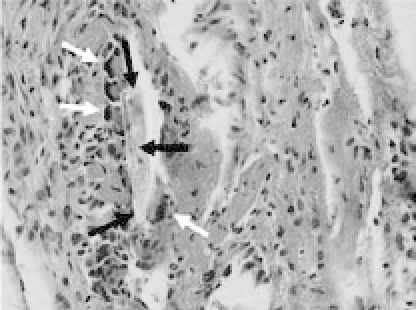Biomedical Engineering Reference
In-Depth Information
Figure 1.5.
Foreign-body granuloma. Small PLGA debris (black arrows)
brokenofffromthePLGAfilmandsurroundedbymacrophagesandmultin-
ucleated giant cells (white arrows). These induced macrophages, and mult-
inucleated giant cells were remaining over 2 months.
1.2.3.2 Polyanhydride
Polyanhydride is synthesized by the reaction of diacids with anhy-
dridetoformacetylanhydrideprepolymers.High-molecular-weight
anhydrides are synthesized from the anhydride prepolymer in melt
condensation. Polyanhydrides were modified with the reaction of
imides to increase the physical properties. A typical example is
copolymerization with aromatic imide monomers to increase the
mechanical properties resulting in the polyanhydride-
co
-imide for
the application of hard-tissue engineering. To control degradabil-
ity and enhance mechanical properties, photocrosslinkable func-
tional groups were introduced by the substituted methacrylate
groups on polyanhydrides for the application of orthopedic tis-
sue engineering.
16
The degradation mechanism of polyanhydrides
appears as surface erosion with a highly predictable and controlled
manner, whereas that of poly(
α
-hydroxy ester) is bulk erosion.
To optimize the degradation behavior of anhydride-based copoly-
mers, the controlling of polymer backbone chemistry, the ratio of
monomer, and molecular weightcan be performed.
1.2.3.3 Poly(propylene fumarate)
Poly(propylene fumarate) and its copolymer, biodegradable and
unsaturated linear polyester, were synthesized as potential scaffold









Search WWH ::

Custom Search